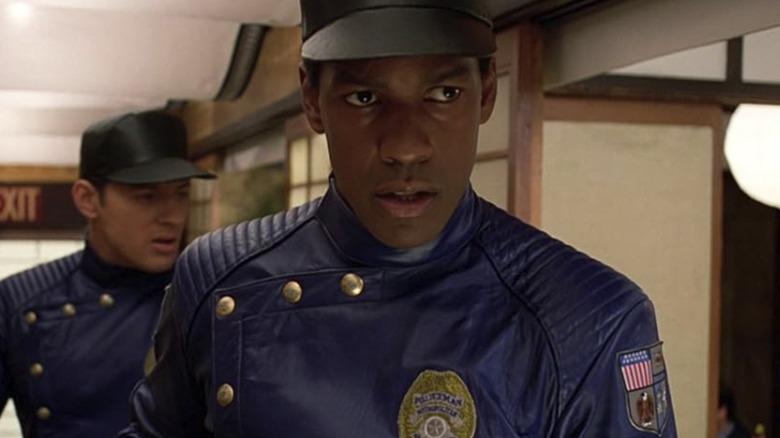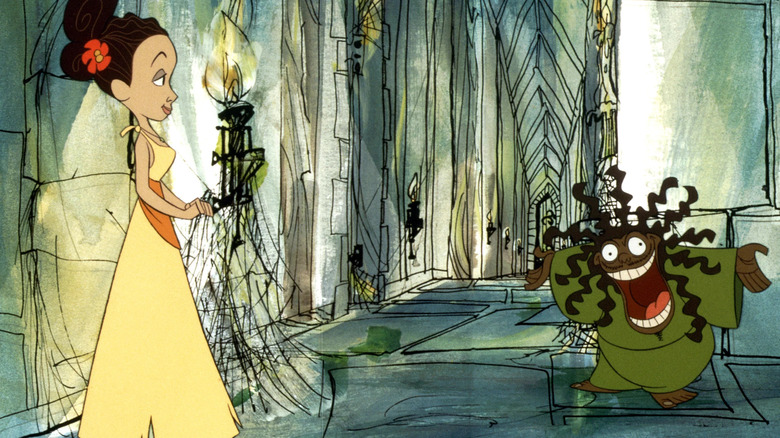Denzel Washington Starred In An Obscure Anthology Series For HBO
Few may remember the show, but from 1995 to 2000, HBO ran an animated anthology series called "Happily Ever After: Fairy Tales for Every Child." Like "Fairy Tale Theater" before it, "Happily Ever After" based each episode around a popular folk story or fairy tale, largely from the Brothers Grimm or Hans Christian Andersen, with each one starring a different cast of notable celebrities. This time, though, the locations of the original European fairy tales were all transposed to new locations around the world. Their "Beauty and the Beast" was set in Northern Africa, for instance. Their "Snow White" was set in the American Southwest and boasted all Native American characters. Their "Cinderella" features Latina and Latino characters. "The Princess and the Pea" took place in Korea.
"Happily Ever After" was a multicultural attempt to highlight the universality of fairy tales by removing them from their white, European origins. "The Emperor's New Clothes" may have been written by a Dane, but its story and its morals could easily be exported to Japan, for instance. That episode starred George Takei, Gedde Watanabe, and Brian Tochi. Indeed, the showrunners of "Happily Ever After" managed to gather together one of the most impressive lists of celebrity guests one has ever seen in order to fill out their series. They enlisted Oscar-winning actors, comedians, athletes, rappers, and, uh, Regis and Kathie Lee.
The great Denzel Washington played the King character in the "Happily Ever After" rendition of "Rumpelstiltskin," while Robert Townsend played the titular imp. That episode also starred Jasmine Guy, Roscoe Lee Brown, and Sherman Hemsley. And that was all just for one episode. Washington also played both Humpty Dumpty and the Crooked Man in an all-in-one Mother Goose episode. That episode saw Whoopi Goldberg as Mother Goose, Salt-n-Pepa as the Three Little Kittens, Regis Philbin and Kathie Lee Gifford as Jack and Jill, Lauren Tom as Little Miss Muffett, and the star a cappella group Rockapella as the Five Little Pigs.
This show was stacked.
Happily Ever After: Fairy Tales for Every Child spread European tales all across the globe
Some of the stories were repeated. Despite Rockapella playing the Five Little Pigs in "Mother Goose: A Rappin' and Rhymin' Special" (October 12, 1997), "The Three Little Pigs" episode (June 22, 1999) came immediate after, and that episode starred Courteney Cox, Loretta Lynn, the inimitable Julie Brown, Tyra Banks, and Sandra Oh. Sinbad played the Big Bad Wolf, and the action surrounded a country music festival.
The most startling casting lineup came in the "Henny Penny" episode (Novmber 2, 1999), as that one starred Sharon Stone as Henny Penny, while the anthropomorphic animal townsfolk were played by Mary Hart, Jesse Jackson, Johnnie Cochran, Alan M. Dershowitz, Geraldine A. Ferraro, Rudy Giuliani, John McLaughlin, and Henry Kissinger (!).
I would continue to run down the celebrity guests that appeared on "Happily Ever After," but there are simply too many famous people to name in a short article. Suffice to say, over its three seasons and 39 episodes, "Happily Ever After" accrued a list of performers even more impressive than "Tales from the Crypt." Everyone wanted to be a part of this series. It seemed so refreshing that so many Black, Asian, Latino, and other non-white characters were featured in stories that had, up to that point, rested firmly in the purview of white Disney productions. The early 1990s saw a huge explosion of racial diversity in popular entertainment, and "Happily Ever After" was an inclusive, high-quality antidote to the racially homogenous world of most old-world Disney productions.
The seasons aired sporadically, produced as scheduling and budget permitted. The first season of "Happily Ever After" aired from March 12 to June 4, 1995, and the second season didn't begin until April 13, 1997. The third season began in late June 1999.
Happily Ever After was ahead of its time
The animation studio behind "Happily Ever After" was Hyperion Pictures, the studio that oversaw animation on the early-'90s feature films "The Brave Little Toaster," "Rover Dangerfield," and "Bebe's Kids." One can see the animation style of "Bebe's Kids" in "Happily Ever After," with its style of caricatures. On TV, Hyperion oversaw the Louie Anderson animated series "Life With Louie," as well as "The Proud Family." They also did the "Family Dog" episode of "Amazing Stories," as well as the amazingly weird 1996 kiddie horror series "Bone Chillers." Hyperion hasn't produced anything since 2007.
The animation and writing on "Happily Ever After" was on par with most studio animated shows of its era, and certainly had multiple episodes that looked rushed; that came with animation practices of the time. The stories were also as gentle as anyone might expect, not emerging as striking and daring in any aspect other than its design and its pointed racial diversity. Disney would eventually employ similar diversity decades later; its animated film "The Princess and the Frog" was transposed to the bayous of Louisiana and boasted multiple Black lead characters.
Frustratingly, "Happily Ever After," while set in various nations around the world, didn't make any episodes about the folklore and fairy tales that originated from those regions. Indeed, the only fairy tale featured on "Happily Ever After" that did not originate in Europe or the United States was "Ali Baba and the Forty Thieves." Jurnee Smollett played Ali Baba. It would have been nice to include an exploration of the entire world's folklore in addition to diversifying the existing European versions.
The series lasted three seasons and is currently available on HBO Max. It's light and good, and worth watching for the voice cast alone. The animation may look dated to modern eyes, but no more so than, say, 1995 episodes of "Animaniacs." Few may remember the series now, but it was daring at the time, and worthy of revisitation today.


